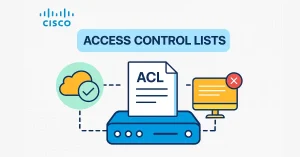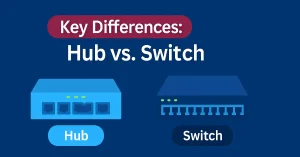The word “IP ” stands for “Internet Protocol.” An Internet Protocol or IP Address is a unique logical numeric address assigned to every computer, printer, switch, router, or network device. It is the core component of the TCP/IP network. There is no possibility of a network without an IP address. IP addresses such as 192.168.1.1 uniquely identify every host in the network. There are two parts of the IP address.
Every device connected to a network, from your smartphone to a web server, relies on an IP address to communicate. Whether browsing the internet or streaming videos, IP addresses ensure data reaches the right destination. This article dives deep into what addresses are, their role in networking, and key concepts like IPv4, IPv6, subnetting, and security. Let’s start with the basics.
Why Are IP Addresses Important?
IP addresses serve two primary functions:
- Identification: They uniquely identify devices on a network, like a phone number for a device.
- Routing: They guide data packets to their destination, ensuring your email or webpage reaches the correct server or device.
Without IP addresses, devices couldn’t communicate, making networking impossible. They’re managed by protocols and organizations like the Internet Assigned Numbers Authority (IANA).
The network part of the IP Address
The network part specifies the unique number assigned to the network and identifies the class of the IP address. All hosts in a network are grouped in a single IP address range, called its net or subnet.
The host part of the IP Address
This is part of identifying the host uniquely in the network. Each host assigns a unique address from the network’s range. Each network has a different address range; routers on layer 3 connect these networks.
Note: For each host on the network, the network part of the address will be the same, but the host part should be different.
How Do IP Addresses Work?
As network devices generate TCP or UDP segments, a header with source IP address and destination IP address, among other information, is added. This PDU (protocol data unit) is called a packet. When a router receives a packet, it looks at the destination address in the header and forwards it to the destination network. The packet may pass through multiple routers before it reaches the destination network. Each router it has to go through is called a hop.
IP address Fields
This field plays a very important role in sending data through different hops. Version 4 is the most used in today’s networking. The Figure below illustrates the header structure of the IPv4 address.
Version
This field shows the version of the IP. For IPv4 address, this value is 4.
Header Length
Header length specifies the size of the header itself. The smallest size is 20 bytes. The figure does not show a variable-length’s rarely used options field. Most IPv4 headers are 20 bytes in length.
DS Field
The Differentiated Services field marks packets for different quality-of-service (QoS) levels. For example, data belonging to voice and video protocols is not accepted for delay. The DS field marks packets carrying data belonging to these protocols so that they get priority treatment through the network. On the other hand, peer-to-peer traffic is considered a significant problem and can be marked down to give the best-effort treatment.
Total Length
The total length field specifies the size of the packet. The length contains the header size, including the data size.
Identification
When a device receives a segment from TCP or UDP, It may be required to break the segment into chunks called fragments before sending it out to the network. Identification fields find the fragments that make up the original segment. Each fragment of a segment will have the same identification number.
Flags
Used for the fragmentation process.
Fragment Offset
The fragment offset field identifies the fragment number so that the segment can be reassembled in the correct order.
Time to Live (TTL)
The TTL value is set to the originating host. Each router that the packet passes through reduces the TTL by one. The packet is dropped if the TTL reaches 0 before reaching the destination. This is done to prevent the packet from moving around the network endlessly.
Protocol
The protocol field identifies the protocol to which the data belongs. For example, a value of 6 implies that the data has a TCP segment, while a value of 17 signifies a UDP segment. In addition to TCP and UDP, many protocols can carry data in an IP packet.
Header Checksum
The header checksum field is used to check for errors in the header. For each router and at the destination, a cyclic redundancy check is performed on the header, and the result should match the value stored in this field. If the value does not match, the packet is discarded.
Source IP address
This field stores the IP of the source of the packet.
Destination IP address
This field stores the IP of the packet’s destination.
IP Address Security and Privacy
IP addresses pose security and privacy risks, as they reveal device locations and enable tracking.
Risks
- IP Spoofing: Attackers fake IP addresses to impersonate devices.
- Tracking: Websites log public IPs, potentially linking them to user behavior.
- DDoS Attacks: Public IPs are targets for denial-of-service attacks.
Solutions
- VPNs: Mask your public IP by routing traffic through a server (e.g., NordVPN).
- Firewalls: Block unauthorized access to your IP.
- NAT: Hides private IPs behind a public IP.
- IPv6 Privacy Extensions: Randomize IPv6 addresses to reduce tracking.
How to Find Your IP Address
Finding your IP is simple. Here’s how:
On Windows
- Open Command Prompt (Win + R, type cmd).
- Type ipconfig and press Enter.
- Look for “IPv4 Address” (e.g., 192.168.1.5) under your active network.
On Linux/Mac
- Open Terminal.
- Type ifconfig or ip addr and press Enter.
- Find your IP under the active interface (e.g., eth0 or wlan0).
Public IP
- Visit sites like whatismyipaddress.com to see your public IP (e.g., 203.0.113.1).
FAQs
What is an IP address, and why is it essential in 2025?
An IP address is a unique numerical label identifying devices on a network, acting as a digital address for data delivery. In 2025, it’s crucial for internet connectivity, streaming, and communication, managed by IANA to support growing IoT and smart device demands.
How does IPv4 differ from IPv6 in today’s networks?
IPv4, with 32 bits, offers 4.3 billion addresses, nearing exhaustion, while IPv6’s 128 bits provide trillions for IoT growth. By 2025, IPv6 adoption rises to handle smart devices, offering better scalability and security features.
What are the main security risks of using a public IP address?
Public IPs face IP spoofing, where attackers fake identities, tracking by websites, and DDoS attacks. In 2025, these risks grow with cyber threats, necessitating VPNs and firewalls to protect your online presence and data.
How can I secure my IP address with modern tools in 2025?
Use a VPN like NordVPN to mask your public IP, encrypt traffic, and bypass restrictions. Pair with firewalls and NAT for added protection against 2025’s rising cyber threats, ensuring privacy on growing smart networks.
Where can beginners learn more about IP addresses in 2025?
Explore NetworkUstad’s IP Address Classes Guide or quizzes for hands-on learning. Consult CCNA-certified experts like Asad Ijaz for 2025 trends, offering insights into networking basics and security via daily articles.
What are the different classes of IPv4 addresses ?
IPv4 classes include A (1-126.x.x.x, large networks), B (128-191.x.x, medium), C (192-223.x.x, small), D/E (multicast/experimental). In 2025 CCNA, focus on private ranges like 192.168.x.x for subnetting practice.





